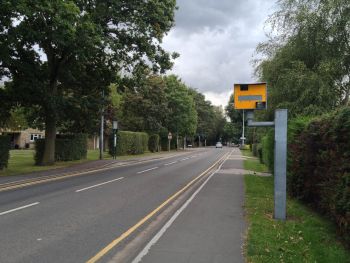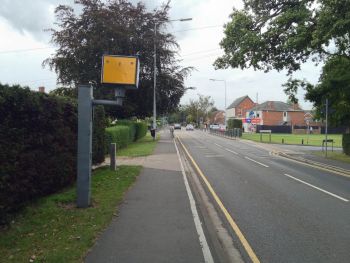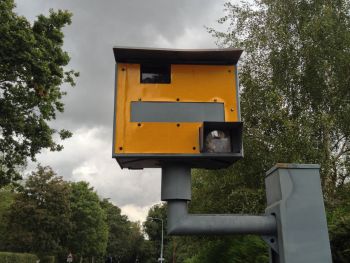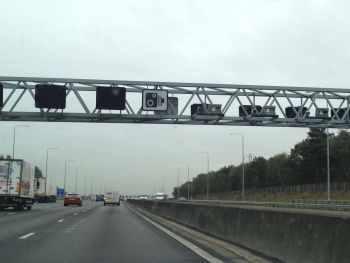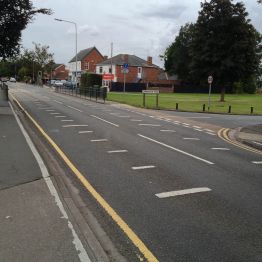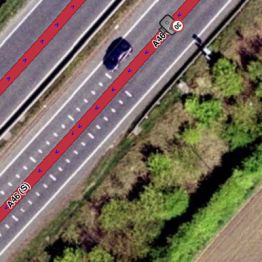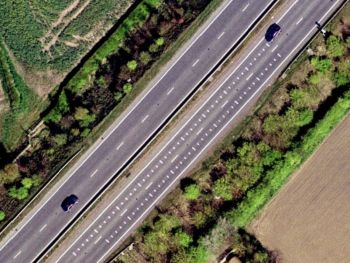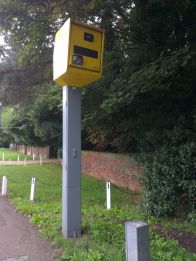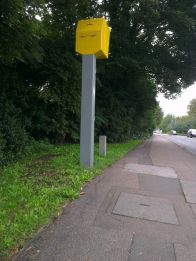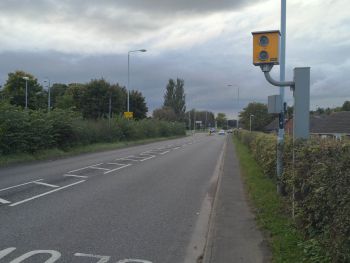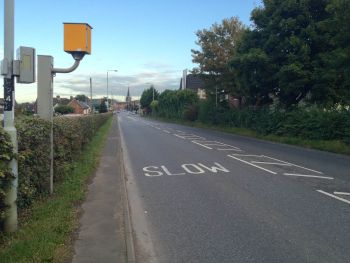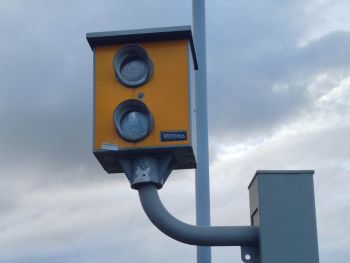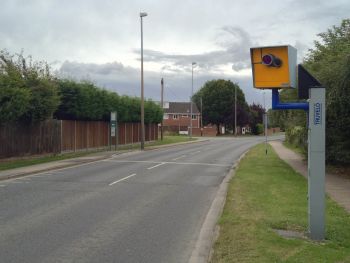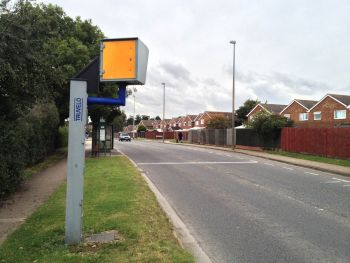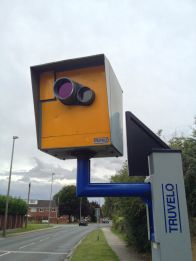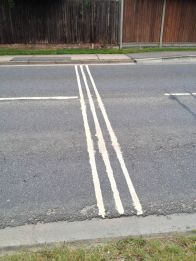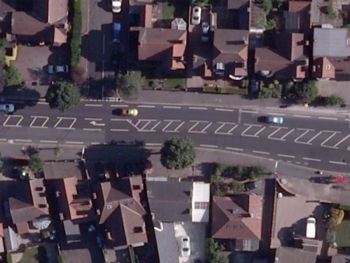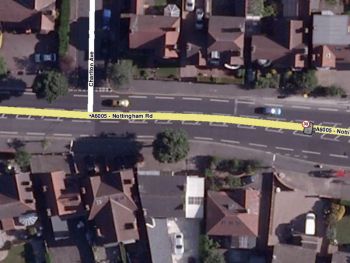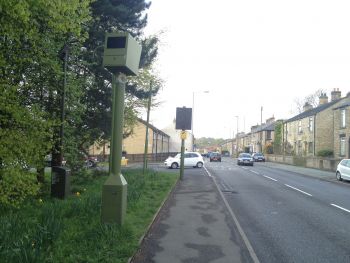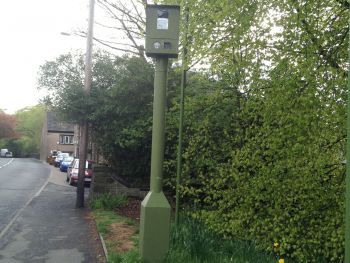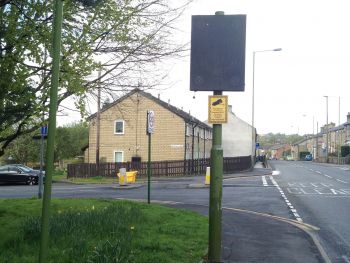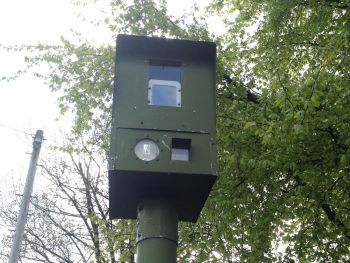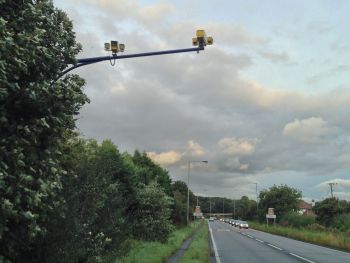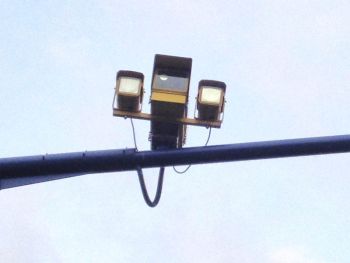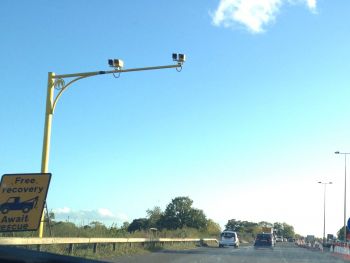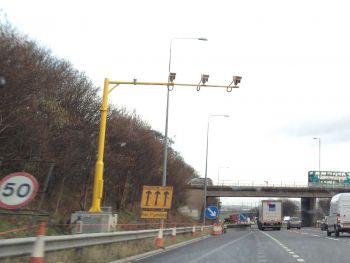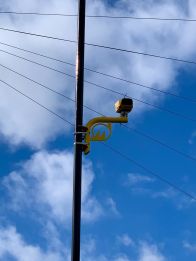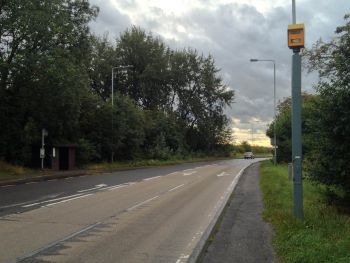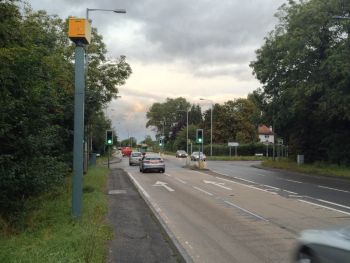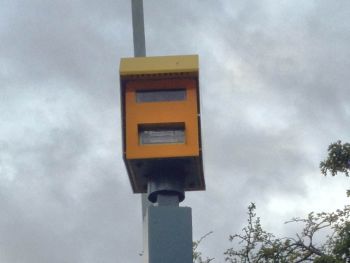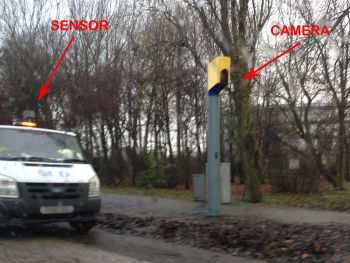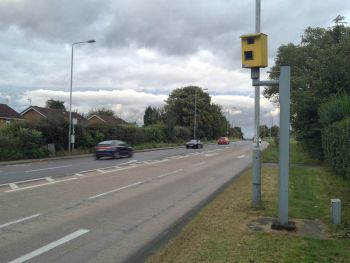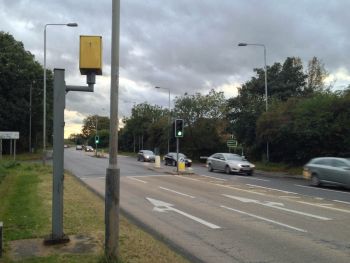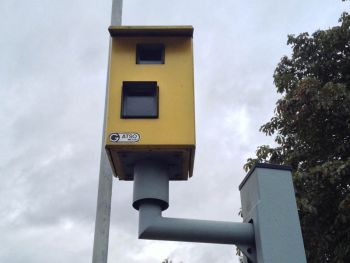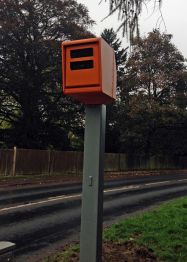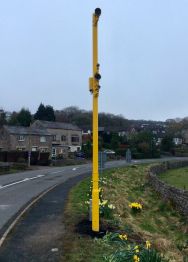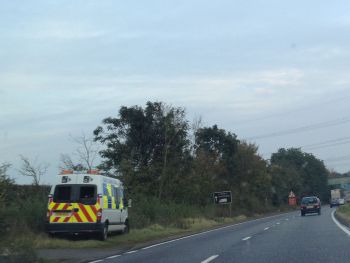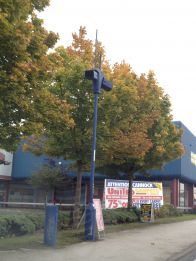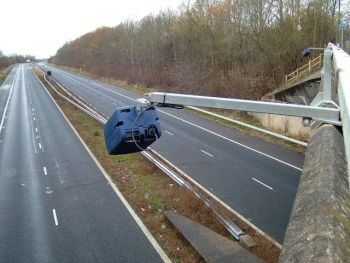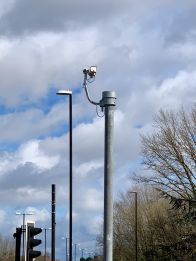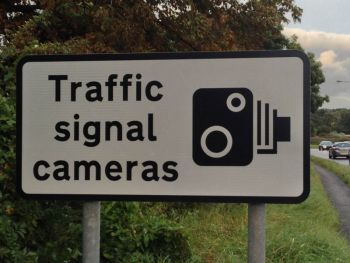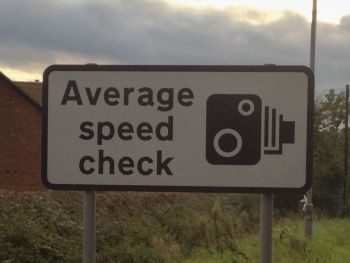Kkervinjones (talk | contribs) No edit summary |
Kkervinjones (talk | contribs) No edit summary |
||
| Line 10: | Line 10: | ||
[[Average Speed Zones | Average Speed Cameras]] should be mapped as per the linked guidance | [[Average Speed Zones | Average Speed Cameras]] should be mapped as per the linked guidance | ||
Mobile speed cameras (camera vans) should '''not''' be mapped in Waze, | Mobile speed cameras (camera vans) should '''not''' be mapped in Waze. Instead, they should be reported in the app using ''Report > Police > Visible''. | ||
{{Mbox|type=info|text=The speed limit sign shown on the WME speed camera icon is only an image and always shows '''30''', irrespective of the set speed limit.}} | {{Mbox|type=info|text=The speed limit sign shown on the WME speed camera icon is only an image and always shows '''30''', irrespective of the set speed limit.}} | ||
| Line 20: | Line 20: | ||
CCTV cameras at level crossing should '''not''' be mapped in Waze. | CCTV cameras at level crossing should '''not''' be mapped in Waze. | ||
{{Mbox|type=important|text=It is increasingly common for red light cameras to | {{Mbox|type=important|text=It is increasingly common for red light cameras also to enforce speed limits, often referred to as '''speed on green''', as Waze does not have a dual camera type, these should be mapped as a Red Light Camera.}} | ||
===Dummy Cameras=== | ===Dummy Cameras=== | ||
| Line 27: | Line 27: | ||
Dummy cameras should only be mapped when a camera housing is present but is either inactive, only the camera housing, or has been bagged over. | Dummy cameras should only be mapped when a camera housing is present but is either inactive, only the camera housing, or has been bagged over. | ||
There are rare occasions when a fake camera | There are rare occasions when residents erect a fake camera to deter speeding traffic; these can also be mapped as Dummy cameras if reported by Wazers. | ||
<br /> | <br /> | ||
==Camera Placement== | ==Camera Placement== | ||
When mapping a camera, you should examine clues on the map and aerial photography to assist in moving the camera to the correct position. You should be aware | When mapping a camera, you should examine clues on the map and aerial photography to assist in moving the camera to the correct position. You should be aware that aerial photography (including road markings) and services such as Street View are often outdated, so do not rely on them exclusively. | ||
The camera types listed below aim to assist you in placing the camera in the correct position. Unfortunately every situation | The camera types listed below aim to assist you in placing the camera in the correct position. Unfortunately, this guide cannot cater to every situation, so your judgment is required. | ||
To move the camera select it and a circle will appear around it, the camera can then be moved anywhere in the circle. If it needs to be moved further | To move the camera select it and a circle will appear around it, the camera can then be moved anywhere in the circle. If it needs to be moved further, move it as far as allowed and save. Then, reload the page with the "permalink" button at the bottom right of the editor screen. Once reloaded the circle will be re-centred on the camera again, repeat until the camera is in the desired position. | ||
{| align="center" | {| align="center" | ||
|[[Image:UK_Cams_WME_Placement1.jpg|thumb|center|300px|Camera Orientation]] | |[[Image:UK_Cams_WME_Placement1.jpg|thumb|center|300px|Camera Orientation]] | ||
|[[Image:UK_Cams_WME_Placement2.jpg|thumb|center|300px|Camera can be moved inside the circle]] | |[[Image:UK_Cams_WME_Placement2.jpg|thumb|center|300px|Camera can be moved inside the circle]] | ||
|} | |} | ||
The red dot in front of the camera indicates the direction of travel and should be the same direction (facing the back of the car after it has driven past) regardless of camera type. If the camera is reversible you | The red dot in front of the camera indicates the direction of travel and should be the same direction (facing the back of the car after it has driven past) regardless of camera type. If the camera is reversible, you must map two cameras, one facing in each direction. | ||
===Setting camera speed and type=== | ===Setting camera speed and type=== | ||
[[File:Camera-properties.png|right|frameless]] | [[File:Camera-properties.png|right|frameless]] | ||
When the camera is selected you | When the camera is selected, you can enter the speed in MPH that matches the speed limit the camera enforces. | ||
When a speed is set the Wazer will receive an audible warning | When a speed is set, the Wazer will receive an audible warning from the client when approaching the camera whilst exceeding the speed set. If no speed is set (''0 mph''), the Wazer will always receive an audible warning. | ||
{{Mbox|type=warning|text=In variable speed limit areas the speed of the camera mapped in Waze should be set to the '''maximum''' permitted speed (e.g. 70mph for the M42).}}{{Mbox|type=info|text=Red Light Cameras should '''always''' be set to '''0mph''' to ensure they always alert in the app.}} | {{Mbox|type=warning|text=In variable speed limit areas the speed of the camera mapped in Waze should be set to the '''maximum''' permitted speed (e.g. 70mph for the M42).}}{{Mbox|type=info|text=Red Light Cameras should '''always''' be set to '''0mph''' to ensure they always alert in the app.}} | ||
===Locking of cameras=== | ===Locking of cameras=== | ||
Cameras still use the legacy locking mechanism that follows the rank of the last editor to touch them. Therefore all cameras, regardless of type, '''should''' be manually locked to '''match''' the lock level of the segment they are placed on. | Cameras still use the legacy locking mechanism that follows the rank of the last editor to touch them. Therefore, all cameras, regardless of type, '''should''' be manually locked to '''match''' the lock level of the segment they are placed on. | ||
==Cameras that should be mapped== | ==Cameras that should be mapped== | ||
===Gatso Speed Cameras=== | ===Gatso Speed Cameras=== | ||
Gatso speed cameras are the most common | Gatso speed cameras are the most common type in the UK and are '''rear facing'''; when triggered, they will flash. They ''may'' be mounted on their post (which may be reversible) or on an overhead gantry (''these are being phased out in favour of HADECS3 side mounted cameras''). | ||
These cameras use radar to measure the speed of a vehicle and typically a series of road markings are placed on the road in front of the camera, often on both lanes to catch drivers overtaking or driving on the wrong side of the road. These markings may also be behind the camera | These cameras use radar to measure the speed of a vehicle and typically a series of road markings are placed on the road in front of the camera, often on both lanes to catch drivers overtaking or driving on the wrong side of the road. These markings may also be behind the camera. This is a good indication of a reversible camera. | ||
Where aerial photography is of good enough quality it is possible to see the road markings aiding the placement of the camera. | Where aerial photography is of good enough quality, it is possible to see the road markings aiding the placement of the camera. | ||
<gallery mode="packed" heights="175px" class="center"> | <gallery mode="packed" heights="175px" class="center"> | ||
File:UK Cams Gatso Front.jpg|Front of Gatso camera <br />''Credit: [[User:Dave2084|Dave2084]]'' | File:UK Cams Gatso Front.jpg|Front of Gatso camera <br />''Credit: [[User:Dave2084|Dave2084]]'' | ||
| Line 68: | Line 68: | ||
===Gatso "Smart Pole" Speed Cameras=== | ===Gatso "Smart Pole" Speed Cameras=== | ||
The [http://www.crown-international.co.uk/smart-pole/gatso-serco-smart-pole/ Gatso Smart Pole] another camera variant being deployed around the UK which uses the same technology as the standard digital Gatso cameras introduced in 2007 with a vandal resistant pole. As with the standard unit it is '''rear facing''' | The [http://www.crown-international.co.uk/smart-pole/gatso-serco-smart-pole/ Gatso Smart Pole] is another camera variant being deployed around the UK which uses the same technology as the standard digital Gatso cameras introduced in 2007 with a vandal-resistant pole. As with the standard unit, it is '''rear facing''' and will flash when triggered. | ||
Where aerial photography is of good enough quality it is possible to see the road markings aiding the placement of the camera. | Where aerial photography is of good enough quality, it is possible to see the road markings aiding the placement of the camera. | ||
Take care not to confuse these cameras with [[#Level_Crossing_Cameras|Level Crossing Cameras]] which | Take care not to confuse these cameras with [[#Level_Crossing_Cameras|Level Crossing Cameras]], which appear similarly. | ||
<gallery mode="packed" heights="175px" class="center"> | <gallery mode="packed" heights="175px" class="center"> | ||
File:UK Cams Gatso Smart Pole Front.jpg|Front of Gatso Smart Pole camera <br />''Credit: Twister-UK'' | File:UK Cams Gatso Smart Pole Front.jpg|Front of Gatso Smart Pole camera <br />''Credit: Twister-UK'' | ||
| Line 79: | Line 79: | ||
===Peek Speed Cameras=== | ===Peek Speed Cameras=== | ||
Peek speed cameras are similar to Gatso cameras in that they are rear facing and when triggered they will flash. | Peek speed cameras are similar to Gatso cameras in that they are rear-facing, and when triggered, they will flash. | ||
These cameras can use radar ''or'' sensors embedded in the road to measure the speed of a vehicle and typically no markings are painted on the road, | These cameras can use radar ''or'' sensors embedded in the road to measure the speed of a vehicle, and typically, no markings are painted on the road. However, as older cameras are being upgraded to this new type of camera, legacy markings may remain in the road. | ||
Where aerial photography is of good enough quality, it can | Where aerial photography is of good enough quality, it can aid in correct camera placement in Waze Map Editor. | ||
<gallery mode="packed" heights="175px" class="center"> | <gallery mode="packed" heights="175px" class="center"> | ||
File:UK Cams Peek Front.jpg|Front of Peek camera <br />''Credit: [[User:Dave2084|Dave2084]]'' | File:UK Cams Peek Front.jpg|Front of Peek camera <br />''Credit: [[User:Dave2084|Dave2084]]'' | ||
| Line 91: | Line 91: | ||
===Truvelo Speed Cameras=== | ===Truvelo Speed Cameras=== | ||
Truvelo cameras differ from Gatso and Peek cameras in that they are front facing, since they are Infra Red, when triggered you will NOT see any flash. They may also be configured in a rear facing arrangement although this is not common. | Truvelo cameras differ from Gatso and Peek cameras in that they are front facing, since they are Infra Red, when triggered you will NOT see any flash. They may also be configured in a rear-facing arrangement, although this is not common. | ||
These cameras use sensors embedded in the road rather than radar to measure the speed of a vehicle and typically the road is marked with three white lines in front of the camera across one or both lanes. These markings may also be behind the camera | These cameras use sensors embedded in the road rather than radar to measure the speed of a vehicle, and typically, the road is marked with three white lines in front of the camera across one or both lanes. These markings may also be behind the camera. This is a good indication of a reversible camera. | ||
Where aerial photography is of good enough quality, it can | Where aerial photography is of good enough quality, it can aid in correct camera placement in Waze Map Editor. | ||
<gallery mode="packed" heights="175px" class="center"> | <gallery mode="packed" heights="175px" class="center"> | ||
File:UK Cams Truvelo Front.jpg|Front of Truvelo Camera <br />''Credit: [[User:Dave2084|Dave2084]]'' | File:UK Cams Truvelo Front.jpg|Front of Truvelo Camera <br />''Credit: [[User:Dave2084|Dave2084]]'' | ||
| Line 106: | Line 106: | ||
===Watchman Speed Cameras=== | ===Watchman Speed Cameras=== | ||
Watchman cameras are | Watchman cameras are unique among UK safety cameras in that they are an integrated system with several sensors comprising a speed warning board and a camera, both with their radar, as shown below. At this time, it is unclear if these cameras are approved by the Home Office (and thus able to be used for prosecution). | ||
[[Image:UK_Cams_Watchman_System.jpg|center]] | [[Image:UK_Cams_Watchman_System.jpg|center]] | ||
Where aerial photography is of good enough quality, it can | Where aerial photography is of good enough quality, it can aid in correct camera placement in Waze Map Editor. | ||
<gallery mode="packed" heights="175px" class="center"> | <gallery mode="packed" heights="175px" class="center"> | ||
File:UK Cams Watchman System Rear.jpg|Watchman system viewed from the rear<br />''Credit: [[User:Dave2084|Dave2084]]'' | File:UK Cams Watchman System Rear.jpg|Watchman system viewed from the rear<br />''Credit: [[User:Dave2084|Dave2084]]'' | ||
| Line 119: | Line 119: | ||
=== VECTOR-SR Cameras === | === VECTOR-SR Cameras === | ||
These devices can identify speeding drivers travelling in both directions, | These devices can identify speeding drivers travelling in both directions, don't flash when they snap, and catch motorists not wearing a seatbelt or handling a mobile phone at the wheel. | ||
[[File:VECTOR-SR.jpg|center]] | |||
They can also act as Red Light Cameras if placed near traffic lights. If so, they should be mapped as a Red Light Camera. | |||
===Average Speed Cameras=== | ===Average Speed Cameras=== | ||
SPECS ('''SPE'''ed '''C'''heck '''S'''ervices) and VECTOR are a system that uses number plate recognition to measure the time taken between two fixed points to monitor a driver's average speed. There are | SPECS ('''SPE'''ed '''C'''heck '''S'''ervices) and VECTOR are a system that uses number plate recognition to measure the time taken between two fixed points to monitor a driver's average speed. There are several camera types in use, as shown in the images. However, only one camera type will be used at a given site. | ||
This is not a standalone system, an average speed zone may consist of two or more cameras at entry point, mid point(s) and exit point of the monitored zone. Due to the passive nature of this system no road markings are required. | This is not a standalone system, an average speed zone may consist of two or more cameras at entry point, mid point(s) and exit point of the monitored zone. Due to the passive nature of this system, no road markings are required. | ||
Where aerial photography is of good enough quality, it can | Where aerial photography is of good enough quality, it can aid correct placement of the camera in Waze Map Editor. | ||
{{Mbox|type=notice|text=[[Average Speed Zones]] should be mapped according to the specific guidance.}} | {{Mbox|type=notice|text=[[Average Speed Zones]] should be mapped according to the specific guidance.}} | ||
| Line 141: | Line 143: | ||
</gallery><br /> | </gallery><br /> | ||
===Monitron Speed and Red Light Cameras=== | ===Monitron Speed and Red Light Cameras=== | ||
Monitron speed cameras (sometimes | Monitron speed cameras (sometimes called SpeedCurb) are a new generation of digital cameras configured as a speed '''and''' / '''or''' a red light camera. | ||
These cameras use sensors embedded in the road rather than radar to measure the speed of a vehicle and typically no markings are painted on the road, | These cameras use sensors embedded in the road rather than radar to measure the speed of a vehicle, and typically, no markings are painted on the road. However, as older cameras are being upgraded to this new type of camera, legacy markings may remain in the road. | ||
Where aerial photography is of good enough quality, it can | Where aerial photography is of good enough quality, it can aid in correct camera placement in Waze Map Editor. If the camera is a red light camera, it should be placed on the stop line in Waze Map Editor. | ||
<gallery mode="packed" heights="175px" class="center"> | <gallery mode="packed" heights="175px" class="center"> | ||
| Line 154: | Line 156: | ||
===RedSpeed Speed and Red Light Cameras=== | ===RedSpeed Speed and Red Light Cameras=== | ||
These are new | These are new types of combined Speed and Red Light Camera. | ||
<gallery mode="packed" heights="175px" class="center"> | <gallery mode="packed" heights="175px" class="center"> | ||
| Line 161: | Line 163: | ||
===Gatso Red Light Cameras=== | ===Gatso Red Light Cameras=== | ||
Gatso red light cameras | Gatso red light cameras differ from their speed detection counterparts and will be triggered when driving through a red light. | ||
These cameras use radar to measure the speed of a vehicle and do not normally have any markings on the road other than the stop line for the traffic lights. | These cameras use radar to measure the speed of a vehicle and do not normally have any markings on the road other than the stop line for the traffic lights. | ||
When approving a red light camera in Waze Map Editor it should be placed on the stop line. | When approving a red light camera in Waze Map Editor, it should be placed on the stop line. | ||
<gallery mode="packed" heights="175px" class="center"> | <gallery mode="packed" heights="175px" class="center"> | ||
| Line 177: | Line 179: | ||
* '''Level Crossing Cameras''' | * '''Level Crossing Cameras''' | ||
Take care not to confuse these cameras with [[#Gatso_.22Smart_Pole.22_Speed_Cameras|Gatso "Smart Pole" Cameras]] which are similar in appearance. Level Crossing should be mapped with the Level (Railroad) Crossing feature, one either side of the crossing pointing towards it. | Take care not to confuse these cameras with [[#Gatso_.22Smart_Pole.22_Speed_Cameras|Gatso "Smart Pole" Cameras]], which are similar in appearance. Level Crossing should be mapped with the Level (Railroad) Crossing feature, one on either side of the crossing pointing towards it. | ||
<gallery mode="packed" heights="175px" class="center"> | <gallery mode="packed" heights="175px" class="center"> | ||
Revision as of 22:32, 31 December 2023
| This page forms part of UK Editing Best Practice. Editors are encouraged to follow these guidelines. |
Speed and Red Light cameras can only be added by Editors Ranked L2 and above.
Waze Camera Types
Speed Cameras


Fixed speed enforcement cameras of any type (Gatso, Peek, Truvelo, Monitron or SPECS)
Average Speed Cameras should be mapped as per the linked guidance
Mobile speed cameras (camera vans) should not be mapped in Waze. Instead, they should be reported in the app using Report > Police > Visible.
| The speed limit sign shown on the WME speed camera icon is only an image and always shows 30, irrespective of the set speed limit. |
Red Light Cameras


Fixed cameras enforcing light infringements of any type (Gatso, Monitron, or RedSpeed).
CCTV cameras at level crossing should not be mapped in Waze.
| It is increasingly common for red light cameras also to enforce speed limits, often referred to as speed on green, as Waze does not have a dual camera type, these should be mapped as a Red Light Camera. |
Dummy Cameras


Dummy cameras should only be mapped when a camera housing is present but is either inactive, only the camera housing, or has been bagged over.
There are rare occasions when residents erect a fake camera to deter speeding traffic; these can also be mapped as Dummy cameras if reported by Wazers.
Camera Placement
When mapping a camera, you should examine clues on the map and aerial photography to assist in moving the camera to the correct position. You should be aware that aerial photography (including road markings) and services such as Street View are often outdated, so do not rely on them exclusively.
The camera types listed below aim to assist you in placing the camera in the correct position. Unfortunately, this guide cannot cater to every situation, so your judgment is required.
To move the camera select it and a circle will appear around it, the camera can then be moved anywhere in the circle. If it needs to be moved further, move it as far as allowed and save. Then, reload the page with the "permalink" button at the bottom right of the editor screen. Once reloaded the circle will be re-centred on the camera again, repeat until the camera is in the desired position.
 |
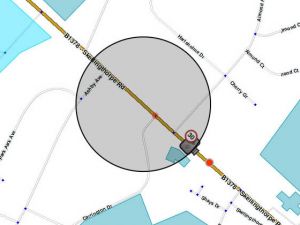 |
The red dot in front of the camera indicates the direction of travel and should be the same direction (facing the back of the car after it has driven past) regardless of camera type. If the camera is reversible, you must map two cameras, one facing in each direction.
Setting camera speed and type
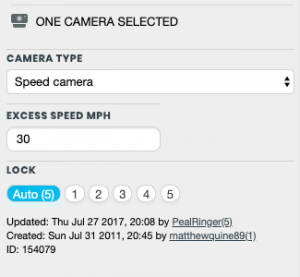
When the camera is selected, you can enter the speed in MPH that matches the speed limit the camera enforces.
When a speed is set, the Wazer will receive an audible warning from the client when approaching the camera whilst exceeding the speed set. If no speed is set (0 mph), the Wazer will always receive an audible warning.
| In variable speed limit areas the speed of the camera mapped in Waze should be set to the maximum permitted speed (e.g. 70mph for the M42). |
| Red Light Cameras should always be set to 0mph to ensure they always alert in the app. |
Locking of cameras
Cameras still use the legacy locking mechanism that follows the rank of the last editor to touch them. Therefore, all cameras, regardless of type, should be manually locked to match the lock level of the segment they are placed on.
Cameras that should be mapped
Gatso Speed Cameras
Gatso speed cameras are the most common type in the UK and are rear facing; when triggered, they will flash. They may be mounted on their post (which may be reversible) or on an overhead gantry (these are being phased out in favour of HADECS3 side mounted cameras).
These cameras use radar to measure the speed of a vehicle and typically a series of road markings are placed on the road in front of the camera, often on both lanes to catch drivers overtaking or driving on the wrong side of the road. These markings may also be behind the camera. This is a good indication of a reversible camera.
Where aerial photography is of good enough quality, it is possible to see the road markings aiding the placement of the camera.
-
Front of Gatso camera
Credit: Dave2084 -
Rear of Gatso camera
Credit: Dave2084 -
Gatso camera close-up
Credit: Dave2084 -
Gatso Cameras on overhead gantry
Credit: Dave2084 -
Gatso camera road markings
Credit: Dave2084 -
Placement in Waze Map Editor
-
Aerial view showing road markings
Gatso "Smart Pole" Speed Cameras
The Gatso Smart Pole is another camera variant being deployed around the UK which uses the same technology as the standard digital Gatso cameras introduced in 2007 with a vandal-resistant pole. As with the standard unit, it is rear facing and will flash when triggered.
Where aerial photography is of good enough quality, it is possible to see the road markings aiding the placement of the camera.
Take care not to confuse these cameras with Level Crossing Cameras, which appear similarly.
-
Front of Gatso Smart Pole camera
Credit: Twister-UK -
Rear of Gatso Smart Pole camera
Credit: Twister-UK
Peek Speed Cameras
Peek speed cameras are similar to Gatso cameras in that they are rear-facing, and when triggered, they will flash.
These cameras can use radar or sensors embedded in the road to measure the speed of a vehicle, and typically, no markings are painted on the road. However, as older cameras are being upgraded to this new type of camera, legacy markings may remain in the road.
Where aerial photography is of good enough quality, it can aid in correct camera placement in Waze Map Editor.
-
Front of Peek camera
Credit: Dave2084 -
Rear of Peek camera
Credit: Dave2084 -
Peek camera close up
Credit: Dave2084
Truvelo Speed Cameras
Truvelo cameras differ from Gatso and Peek cameras in that they are front facing, since they are Infra Red, when triggered you will NOT see any flash. They may also be configured in a rear-facing arrangement, although this is not common.
These cameras use sensors embedded in the road rather than radar to measure the speed of a vehicle, and typically, the road is marked with three white lines in front of the camera across one or both lanes. These markings may also be behind the camera. This is a good indication of a reversible camera.
Where aerial photography is of good enough quality, it can aid in correct camera placement in Waze Map Editor.
-
Front of Truvelo Camera
Credit: Dave2084 -
Rear of Truvelo Camera
Credit: Dave2084 -
Truvelo Camera Close-Up
Credit: Dave2084 -
Truvelo Camera Road Markings
Credit: Dave2084 -
Aerial view showing road markings
-
Placement in Waze Map Editor
Watchman Speed Cameras
Watchman cameras are unique among UK safety cameras in that they are an integrated system with several sensors comprising a speed warning board and a camera, both with their radar, as shown below. At this time, it is unclear if these cameras are approved by the Home Office (and thus able to be used for prosecution).
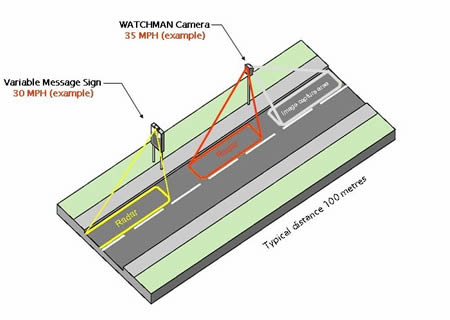
Where aerial photography is of good enough quality, it can aid in correct camera placement in Waze Map Editor.
-
Watchman system viewed from the rear
Credit: Dave2084 -
Watchman camera viewed from the front
Credit: Dave2084 -
Watchman speed warning board
Credit: Dave2084 -
Close up of Watchman camera
Credit: Dave2084
VECTOR-SR Cameras
These devices can identify speeding drivers travelling in both directions, don't flash when they snap, and catch motorists not wearing a seatbelt or handling a mobile phone at the wheel.

They can also act as Red Light Cameras if placed near traffic lights. If so, they should be mapped as a Red Light Camera.
Average Speed Cameras
SPECS (SPEed Check Services) and VECTOR are a system that uses number plate recognition to measure the time taken between two fixed points to monitor a driver's average speed. There are several camera types in use, as shown in the images. However, only one camera type will be used at a given site.
This is not a standalone system, an average speed zone may consist of two or more cameras at entry point, mid point(s) and exit point of the monitored zone. Due to the passive nature of this system, no road markings are required.
Where aerial photography is of good enough quality, it can aid correct placement of the camera in Waze Map Editor.
| Average Speed Zones should be mapped according to the specific guidance. |
-
SPECS camera Type A
Credit: Dave2084 -
SPECS camera Type A close up
Credit: Dave2084 -
SPECS camera Type B
Credit: Dave2084 -
SPECS camera Type C
Credit: Dave2084 -
SPECS cameras on overhead gantry
Credit: Dave2084 -
VECTOR camera
Credit: atrophicshiner
Monitron Speed and Red Light Cameras
Monitron speed cameras (sometimes called SpeedCurb) are a new generation of digital cameras configured as a speed and / or a red light camera.
These cameras use sensors embedded in the road rather than radar to measure the speed of a vehicle, and typically, no markings are painted on the road. However, as older cameras are being upgraded to this new type of camera, legacy markings may remain in the road.
Where aerial photography is of good enough quality, it can aid in correct camera placement in Waze Map Editor. If the camera is a red light camera, it should be placed on the stop line in Waze Map Editor.
-
Front of Monitron camera
Credit: Dave2084 -
Rear of Monitron camera
Credit: Dave2084 -
Monitron camera close up
Credit: Dave2084
RedSpeed Speed and Red Light Cameras
These are new types of combined Speed and Red Light Camera.
-
New RLC Camera Type
Credit: Dave2084
Gatso Red Light Cameras
Gatso red light cameras differ from their speed detection counterparts and will be triggered when driving through a red light.
These cameras use radar to measure the speed of a vehicle and do not normally have any markings on the road other than the stop line for the traffic lights.
When approving a red light camera in Waze Map Editor, it should be placed on the stop line.
-
Front of Gatso Red Light Camera
Credit: Dave2084 -
Rear of Gatso Red Light Camera
Credit: Dave2084 -
Gatso Red Light Camera close up
Credit: Dave2084
Cameras that should not be mapped
- Level Crossing Cameras
Take care not to confuse these cameras with Gatso "Smart Pole" Cameras, which are similar in appearance. Level Crossing should be mapped with the Level (Railroad) Crossing feature, one on either side of the crossing pointing towards it.
-
Level Crossing Camera
Credit: Moley_uk -
RLSE camera at Black Dyke
Credit: atrophicshiner
- Mobile speed cameras - typically situated in a van, should be reported via the app as visible police
- Trafficmaster sensors -typically in a blue or green housing on bridges or poles
- CCTV cameras - can often cover junctions, level crossing, and general highway monitoring
- ANPR cameras - typically in a grey housing mounted on lamp columns
- Other enforcement cameras - do not map bus lane, junction box, etc cameras
- Driver feedback signs
- Camera warning signs
-
Van mounted mobile enforcement camera
Credit: Dave2084 -
Trafficmaster sensor (blue variant)
Credit: Dave2084 -
Trafficmaster sensor mounted on bridge
Credit: Pauline W -
CCTV camera on pole
Credit: atrophicshiner -
Traffic light mounted CCTV camera
Credit: atrophicshiner -
Red Light Camera warning sign
Credit: Dave2084 -
Average Speed Check warning sign
Credit: Dave2084
